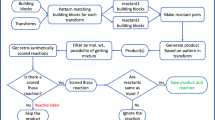Abstract
De novo design systems provide powerful methods to suggest a set of novel structures with high estimated binding affinity. One deficiency of these methods is that some of the suggested structures could be synthesized only with great difficulty. We devised a scoring method that rapidly evaluates synthetic accessibility of structures based on structural complexity, similarity to available starting materials and assessment of strategic bonds where a structure can be decomposed to obtain simpler fragments. These individual components were combined to an overall score of synthetic accessibility by an additive scheme. The weights of the scoring function components were calculated by linear regression analysis based on accessibility scores derived from medicinal chemists. The calculated values for synthetic accessibility agree with the values proposed by chemists to an extent that compares well with how chemists agree with each other.























Similar content being viewed by others
References
Baber JC, Feher M (2004) Mini-Rev Med Chem 4:681
Barone R, Chanon M (2001) J Chem Inf Comput Sci 41:269
Bertz SH (1981) J Am Chem Sci 103:3599
Hendrickson JB, Huang P, Toczko AG (1987) J Chem Inf Comput Sci 27:63
Boda K, Johnson AP (2006) J Med Chem 49:5869
Pförtner M, Sitzmann M, Gasteiger J (eds) (2003) Computer-assisted synthesis design by WODCA. Handbook of chemoinformatics. Wiley-VCH, Weinheim, pp 1447–1507
Molecular Networks GmbH, WODCA Synthesis design by retro-synthetic analysis, http://www.molecular-networks.com/software/wodca/
Johnson AP, Marshall C, Judson PN (1992) J Chem Inf Comput Sci 32:411
Myatt G (1994) Computer aided estimation of synthetic accessibility. PhD thesis, School of Chemistry, University of Leeds, Leeds
Shannon C, Weaver W (1949) Mathematical theory of communications. University of Illinois Press, Urbana, IL
Gasteiger J, Jochum C (1979) J Chem Inf Comput Sci 19:43
Corey E, Cheng X-M (1989) The logic of chemical synthesis. John Wiley & Sons Ltd., New York
Warren S (1982) Organic synthesis: the disconnection approach. John Wiley & Sons Ltd., New York
Willett P (1998) J Chem Inf Comput Sci 38:983
Gasteiger J, Ihlenfeldt WD, Fick R, Rose JR (1992) J Chem Inf Comput Sci 32:700
Ihlenfeldt WD, Gasteiger J (1994) J Comp Chem 15:793
Molecular Networks GmbH, MOSES C++ software library, http://www.molecular-networks.com/software/moses/
Lewell XQ, Judd DB, Watson SP, Hann MM (1998) J Chem Inf Comput Sci 38:511
Acknowledgments
The authors would like to thank the medicinal chemists of our pharmaceutical partner companies (4SC, Altana, Lilly) for evaluating the synthetic accessibility of our dataset. We are also grateful to Elsevier MDL for making available the Theilheimer reaction database for us. We are also grateful to our partners at BioSolveIT and the Center for Bioinformatics (ZBH) of the University of Hamburg for their contributions. Finally, we would like to acknowledge the work and support of the MOSES development team, especially the contribution of Achim Herwig and Oliver Sacher. This work has been financed by the German Federal Ministry of Education and Research (BMBF) as part of the NovoBench project (Project number: 0313324A).
Author information
Authors and Affiliations
Corresponding author
Rights and permissions
About this article
Cite this article
Boda, K., Seidel, T. & Gasteiger, J. Structure and reaction based evaluation of synthetic accessibility. J Comput Aided Mol Des 21, 311–325 (2007). https://doi.org/10.1007/s10822-006-9099-2
Received:
Accepted:
Published:
Issue Date:
DOI: https://doi.org/10.1007/s10822-006-9099-2




